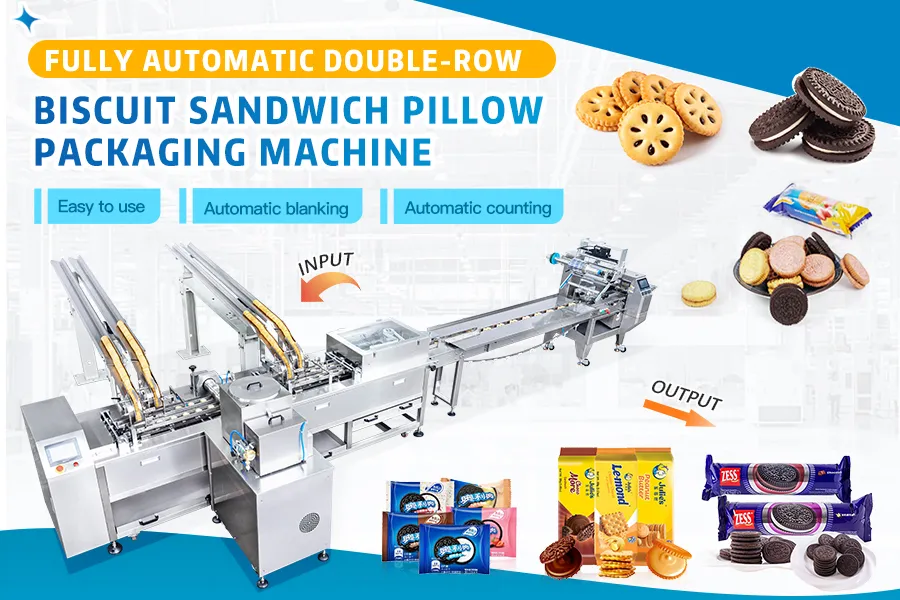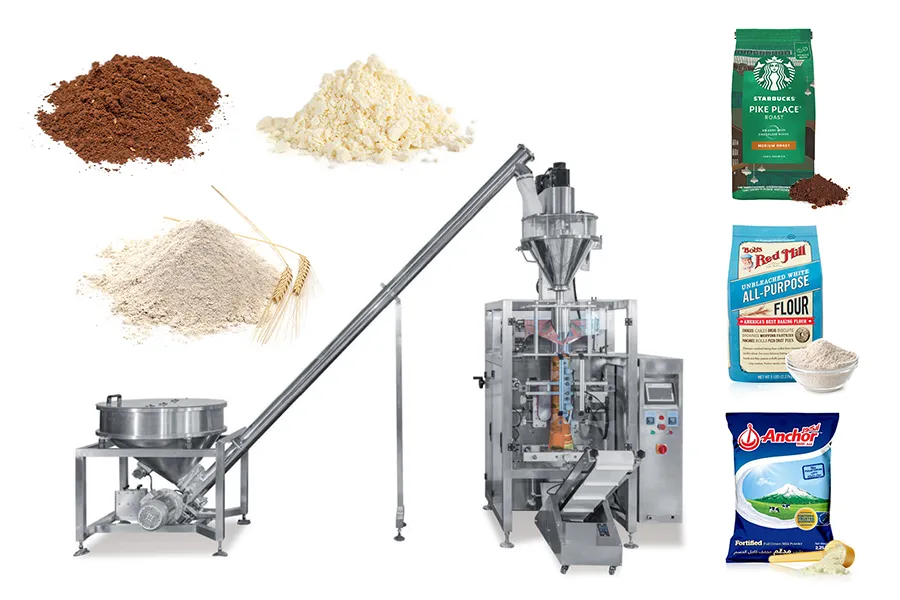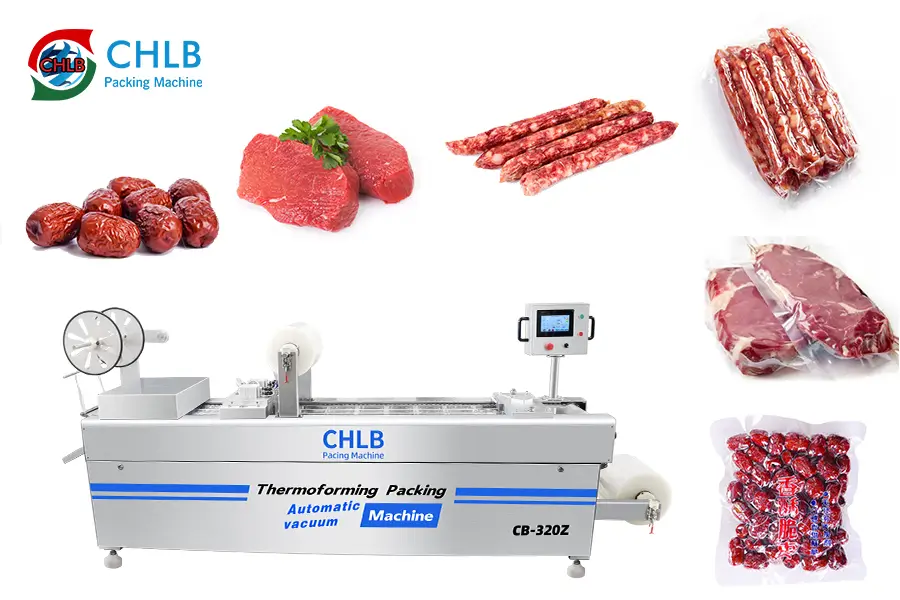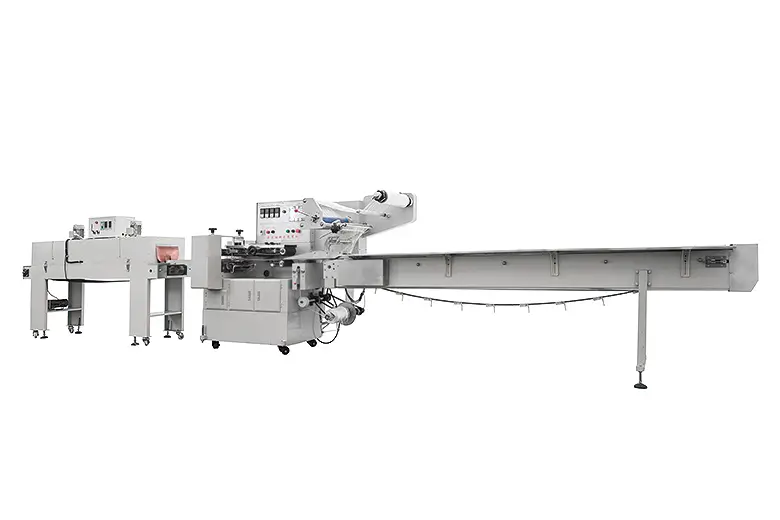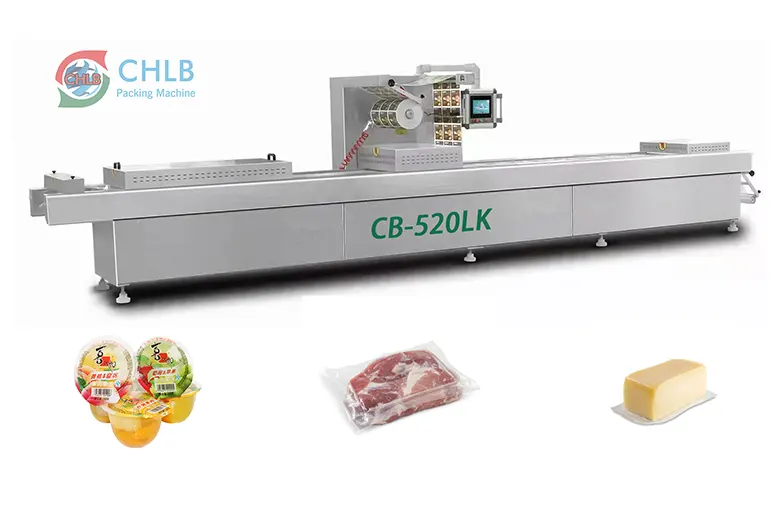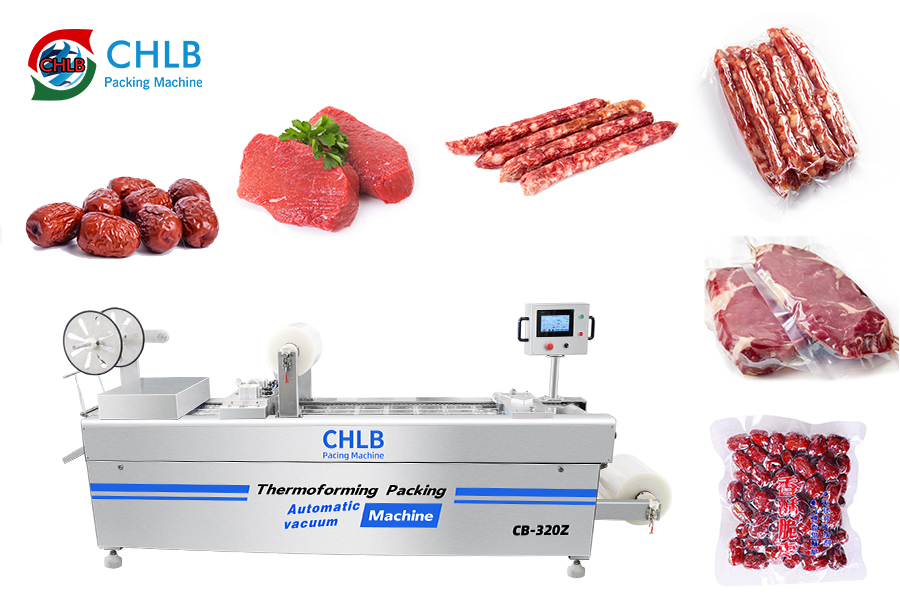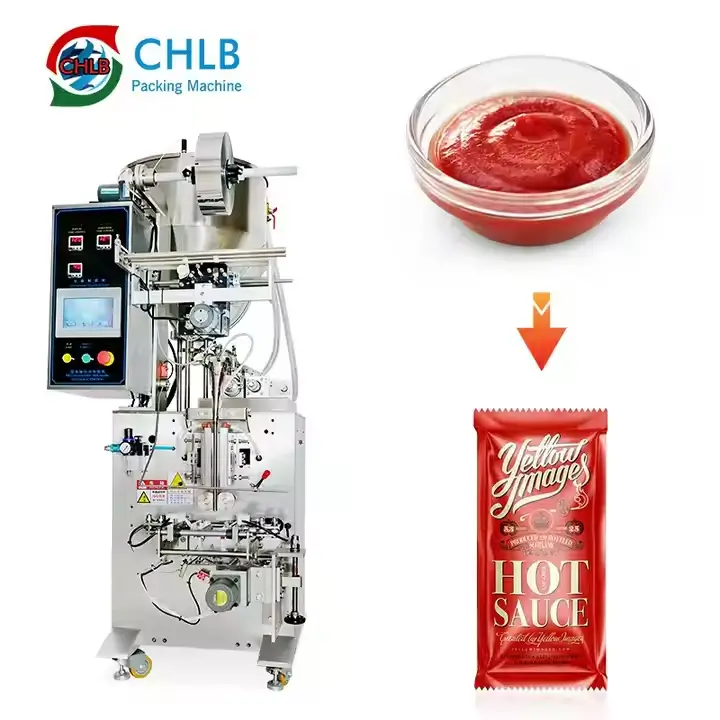Die Lebensmittelverpackung hat sich erheblich weiterentwickelt, Besonders in der Referenz (Rte) Lebensmittelsektor. RTE -Lebensmittel, wie Salate und mikrowellenlose Mahlzeiten, Beschäftigten. Effizienz aufrechtzuerhalten, Hygiene, und Lebensmittelqualität, Erweiterte Verpackungsmaschinen sind unerlässlich. Ready-zufahrende Lebensmittelverpackungsmaschinen gewährleisten die Sicherheit und Frische dieser Produkte. In diesem Ratgeber, Wir werden verschiedene Arten von untersuchen RTE -Lebensmittelverpackungsmaschinen, ihre Arbeitsprozesse, Vorteile, und wichtige Überlegungen zur Auswahl des richtigen für Ihr Unternehmen.
Was ist bereit zu essen (Rte) Essen?
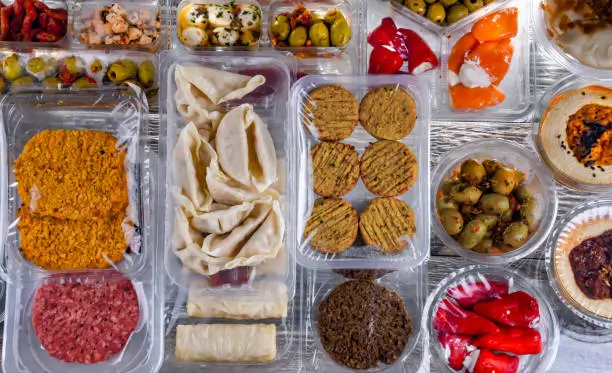
Ready-zu-i-i-i-i-Lebensmittel bezieht sich auf Lebensmittel, die vorbereitet und verpackt sind, Ermöglichen der Verbraucher, sie sofort oder mit minimaler Vorbereitung zu essen. Diese Lebensmittel sind oft in Einzelgrößen in Einsatz. Beispiele für RTE -Lebensmittel sind:
- Vorverpackte Sandwiches
- Gefrorene Mahlzeiten
- Salate
- Snacks
- Dips
- Vorgekochtes Fleisch
Der Hauptvorteil von RTE Foods ist ihre Benutzerfreundlichkeit. Sie beseitigen die Notwendigkeit des Kochens oder einer umfassenden Vorbereitung, sie ideal für Menschen mit geschäftigen Lebensstilen machen. Jedoch, die Qualität und Sicherheit dieser Lebensmittel aufrechtzuerhalten, Sie müssen auf eine Weise verpackt werden, die Frische bewahrt und die Haltbarkeit verlängert.
Was ist einsatzbereit (Rte) Lebensmittelverpackungsmaschinen?
RTE-Lebensmittelverpackungsmaschinen sind spezielle Maschinen, die für die Verpackung von Lebensmitteln in verschiedenen Formaten entwickelt wurden, wie Tabletts, Beutel, oder vakuumsiegelte Taschen. Diese Maschinen führen kritische Aufgaben wie das Füllen aus, Versiegelung, Beschriftung, und inspizieren die verpackten Lebensmittelprodukte. Das Ziel ist es, ein Paket zu erstellen, das sicherstellt, dass das Essen sicher ist zu essen, behält seine Qualität, und ist bequem für den Verbraucher.
Bei Verpackungen geht es nicht nur darum, Lebensmittel während des Transports zu schützen, sondern eine bedeutende Rolle bei der Verlängerung der Haltbarkeit, Verschmutzung verhindern, und Verbesserung der gesamten Verbrauchererfahrung. RTE -Lebensmittelverpackungsmaschinen sind so konstruiert, dass sie verschiedene Verpackungsmaterialien behandeln, Produkttypen, und Produktionsvolumen, Sie zu einem unverzichtbaren Bestandteil des Lebensmittelherstellungsprozesses machen.
Arten von Ready-zu-eat-Lebensmittelverpackungsmaschinen
Es gibt verschiedene Arten von Verpackungsmaschinen,. Jeder Typ bietet unterschiedliche Vorteile, abhängig von den spezifischen Anforderungen des Lebensmittelprodukts und der Produktionslinie. Im Folgenden finden Sie einige der häufigsten Arten von RTE -Lebensmittelverpackungsmaschinen:
1. Horizontales Form-Fill-Seal (HFFS) Maschinen
Horizontales Form-Fill-Seal (HFFS) Maschinen sind ideal für die Verpackung von soliden und semi-soliden Produkten wie Bars, Kekse, und Sandwiches. Diese Maschinen bilden ein Paket aus einer Rolle flexibler Film, Füllen Sie es mit dem Produkt, und versiegeln Sie es, Alles in einem horizontalen Layout. HFFS -Maschinen sind in der Lebensmittelindustrie aufgrund ihrer Geschwindigkeit beliebt, Vielseitigkeit, und die Fähigkeit, eine Vielzahl von Verpackungsformaten zu bewältigen.
HFFS -Maschinen sind besonders nützlich für Produkte, die eine Flussverpackung erfordern, Wo das Produkt in einen Schutzfilm eingewickelt ist, der eine manipulationssichere Siegel bietet. Diese Maschinen sind effizient, Ermöglichen Sie eine Hochgeschwindigkeitsverpackung, die eine Konsistenz in der Portionsgröße und der Produktpräsentation gewährleistet.
2. Vertikaler Form-Fill-Seal (VFFS) Maschinen
Vertikaler Form-Fill-Seal (VFFS) Maschinen sind für Verpackungspulver ausgelegt, Granulat, Flüssigkeiten, und andere ähnliche Produkte. In einer VFFS -Maschine, Das Verpackungsmaterial wird vertikal gefüttert, und die Maschine bildet einen Beutel, Füllt es mit dem Produkt, und versiegelt es. VFFS -Maschinen werden häufig zum Verpacken von Snacks verwendet, Kaffee, Suppen, und Saucen.
Diese Art von Maschine wird in der RTE -Lebensmittelindustrie häufig verwendet, da sie verschiedene Taschengrößen und Verpackungsformate bewältigen kann, Bereitstellung von Flexibilität bei den Produkttypen, die sie verpacken können. VFFS -Maschinen sind bekannt für ihre hohe Effizienz und einfache Funktionsweise, Machen Sie sie zu einer Grundnahrungsmittel in vielen Lebensmittelverpackungsleitungen.
3. Tiefziehverpackungsmaschinen
Tiefziehverpackungsmaschinen werden zum Verpacken von Produkten wie Fleisch verwendet, Käse, und frische Produkte. Diese Maschinen verwenden Wärme, um Kunststofffilm in bestimmte Formen oder Formen zu formen, die dann mit dem Produkt gefüllt und versiegelt werden. Die Verpackung ist in der Regel vakuumversiegelte oder modifizierte Atmosphäre, um die Frische des Produkts aufrechtzuerhalten.
Thermoformierungsmaschinen sind ideal für Verpackungsprodukte, die zusätzlichen Schutz benötigen oder spezifische Schimmelformen erfordern. Sie bieten eine verbesserte Haltbarkeit, Da das Vakuum oder die modifizierte Atmosphäre dazu beitragen. Diese Maschinen eignen sich zum Verpacken einer Vielzahl von Produkten, Von frischem Obst bis zu Deli -Fleisch.
4. Wärmeschrumpfungsmaschinen
Wärmeschrumpfungsmaschinen werden üblicherweise für Verpackungsprodukte wie Tabletts von RTE -Mahlzeiten verwendet, Snacks, und vorgekochte Gegenstände. In diesem Prozess, Das Produkt ist in einen Schrumpffilm platziert, und Wärme wird aufgetragen, um den Film fest um das Produkt umzusetzen. Die resultierende Verpackung von Schrumpfwrap bietet ein manipulationsfreies Siegel, das langlebig und visuell ansprechend ist.
Wärmeschrumpfpackung ist ideal, um mehrere Produkte zusammenzubringen oder Produkte in unregelmäßigen Formen zu schützen. Es hilft, die Haltbarkeit zu verlängern, indem es ein luftdichtes Siegel bereitstellt, Das Essen für längere Zeiträume frisch und sicher halten. Die Schrumpfwrap fügt auch eine Schutzschicht während des Transports und der Handhabung hinzu.
Wie bereit zu essen, die Lebensmittelverpackungsmaschinen funktionieren
Verstehen, wie RTE -Lebensmittelverpackungsmaschinen funktionieren, ist für die Auswahl der richtigen Maschine für Ihr Unternehmen unerlässlich. Der allgemeine Prozess umfasst mehrere Schritte:
Überblick über den Verpackungsprozess
- Produktfüllung: Der erste Schritt im Verpackungsprozess besteht darin, das Paket mit dem Produkt zu füllen. Dies könnte das Abgeben von Flüssigkeiten beinhalten, Granulat, oder feste Lebensmittel in vorgeformte Pakete oder Taschen.
- Versiegelung und Keimeversiegelung: Nachdem das Produkt gefüllt ist, Die Maschinen versiegelt die Packung, um Kontamination zu vermeiden und Frische zu erhalten. Heizversiegelung wird häufig verwendet, um das Verpackungsmaterial zu verbinden, Erstellen eines luftdichten Siegels.
- Etikettierung und Inspektion: Das Paket ist mit wichtigen Produktinformationen gekennzeichnet, wie Zutaten, Ablaufdaten, und Ernährungsdetails. Qualitätsprüfungen werden auch durchgeführt, um sicherzustellen, dass die Verpackung intakt ist und dass die Lebensmittel die Sicherheitsstandards entsprechen.
Automatisierung in der Verpackung: Von manuell bis vollständig automatisiert
Die Automatisierung hat den Verpackungsprozess revolutioniert. Moderne RTE -Lebensmittelverpackungsmaschinen sind hoch automatisiert, minimale manuelle Eingriffe erfordern. Automatisierung verbessert die Effizienz, reduziert den menschlichen Fehler, und beschleunigt die Produktion, Unternehmen erlauben, ihre Geschäftstätigkeit zu skalieren.
Zum Beispiel, Vollautomatisierte Systeme können die Produktfüllung verarbeiten, Versiegelung, Beschriftung, und Inspektion, ohne dass die Betreiber eingreifen müssen. Diese Automatisierung erhöht nicht nur den Durchsatz, sondern stellt auch sicher, dass jedes Paket konsistent versiegelt und korrekt beschriftet ist, Minimierung von Abfall und Maximierung der Effizienz.
Vorteile der Verwendung von RTE -Lebensmittelverpackungsmaschinen
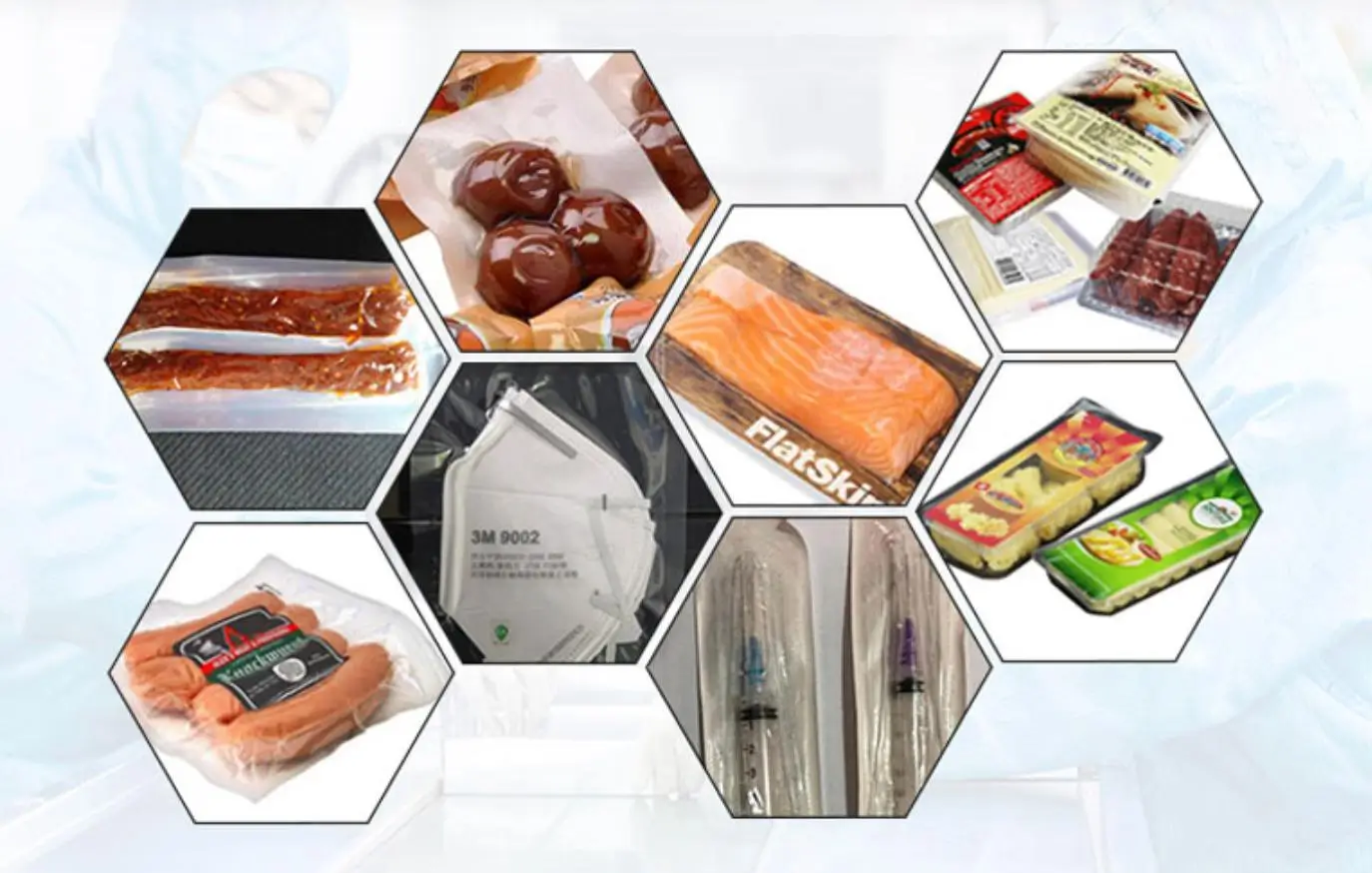
Die Verwendung von RTE -Lebensmittelverpackungsmaschinen bietet mehrere wichtige Vorteile, die sowohl die Produktion als auch die Produktqualität verbessern können.
Erhöhte Haltbarkeitsdauer
Einer der Hauptvorteile bei der Verwendung von RTE -Lebensmittelverpackungsmaschinen ist die Fähigkeit, die Haltbarkeit von verpackten Lebensmitteln zu verlängern. Maschinen wie ThermoFormer und VFFS -Maschinen können Vakuumversiegelung oder modifizierte Atmosphäreverpackung auftragen (KARTE) Techniken zum Entfernen der Luft und zur Verringerung des Wachstums von Bakterien. Dies hilft das Essen länger frisch, Verringerung von Abfall und Erhöhung des Produktwerts des Produkts.
Konsistente Qualität und Portionskontrolle
RTE -Lebensmittelverpackungsmaschinen stellen sicher, dass jedes Produkt konstant verpackt ist. Dies hilft bei der Aufrechterhaltung der Portionskontrolle, Stellen Sie sicher, dass jedes Paket die richtige Produktmenge enthält, Das ist besonders wichtig in der Foodservice -Industrie. Konsequente Qualität sorgt dafür, dass Kunden bei jedem Kauf dieselbe Erfahrung erhalten, Das ist entscheidend für den Ruf der Marken.
Arbeitskosten und Abfall reduzieren
Durch Automatisierung des Verpackungsprozesses, Unternehmen können die Arbeitskosten senken und den menschlichen Fehler minimieren. Maschinen arbeiten mit hoher Geschwindigkeit mit hoher Genauigkeit, was zu weniger Produktabfällen führt. Zusätzlich, Die Automatisierung ermöglicht eine effizientere Verwendung von Materialien, Reduzierung der Wahrscheinlichkeit einer beschädigten oder verschwendeten Verpackung.
Wichtige Funktionen für eine RTE -Lebensmittelverpackungsmaschine
Bei der Auswahl einer RTE -Lebensmittelverpackungsmaschine, Es sollten mehrere Funktionen in Betracht gezogen werden, um sicherzustellen, dass es den Anforderungen Ihres Unternehmens entspricht.
Automatisierung und Effizienz
Suchen Sie nach Maschinen, die automatisiert sind und schnelle Verarbeitungsgeschwindigkeiten anbieten. Dies wird dazu beitragen, die Produktionseffizienz zu steigern und Ausfallzeiten zu minimieren. Die Automatisierung sorgt auch einer genaueren Füllung, Versiegelung, und Beschriftung.
Einhaltung von Hygiene und Lebensmittelsicherheit
Die Lebensmittelsicherheit hat in der Verpackungsbranche oberste Priorität, Besonders für RTE -Lebensmittel. Wählen Sie Maschinen, die den Hygienestandards erfüllen und leicht zu reinigen sind, um eine Kontamination zu verhindern.
Anpassungsoptionen für verschiedene Produkte
Wenn sich Ihr Unternehmen mit einer Vielzahl von RTE -Lebensmitteln befasst, Es ist wichtig, Maschinen auszuwählen, die Anpassungsoptionen für verschiedene Paketgrößen anbieten, Formen, und Materialien. Flexibilität im Verpackungsdesign kann dazu beitragen, verschiedene Verbraucherpräferenzen zu erfüllen.
Energieeffizienz und kostensparende Funktionen
Energieeffiziente Maschinen können die Betriebskosten im Laufe der Zeit erheblich senken. Suchen Sie nach Verpackungsmaschinen mit energiesparenden Funktionen, um die Kosten niedrig zu halten und gleichzeitig eine hohe Leistung aufrechtzuerhalten.
So wählen Sie die richtige RTE -Lebensmittelverpackungsmaschine für Ihr Unternehmen
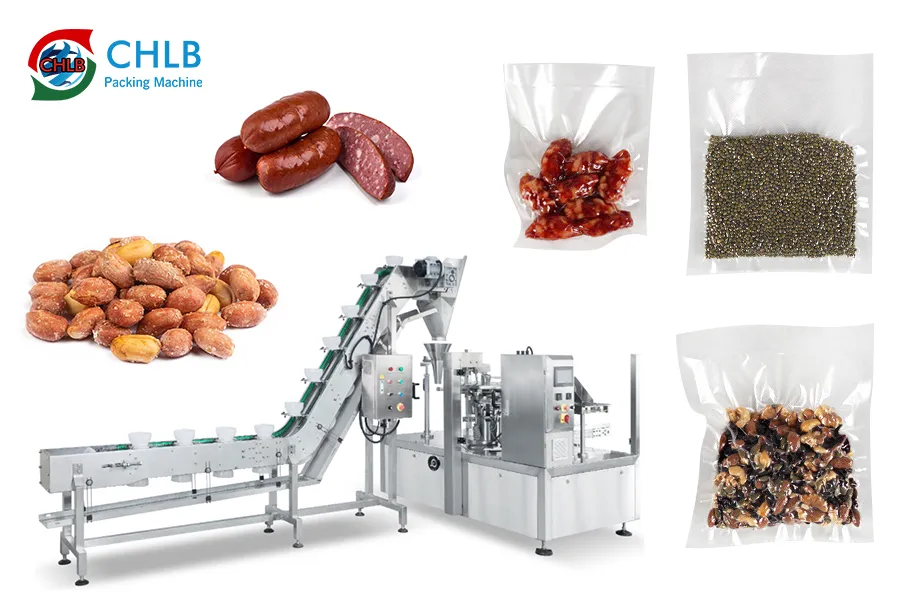
Die Auswahl der richtigen Maschine beinhaltet das Verständnis Ihrer spezifischen Bedürfnisse und die Beurteilung mehrerer Faktoren.
Bewertung Ihres Produktionsvolumens
Bestimmen Sie, wie viel Produkt Sie täglich oder wöchentlich verpacken müssen. Maschinen mit höheren Durchsatzkapazitäten sind für groß angelegte Operationen geeignet, Während kleinere Maschinen für niedrige bis mittlere Produktionsvolumina besser sein können.
Produkteigenschaften verstehen
Unterschiedliche Lebensmittelprodukte haben unterschiedliche Verpackungsanforderungen. Zum Beispiel, Flüssigkeiten benötigen möglicherweise eine andere Art der Versiegelung als feste Lebensmittel, und Produkte, die Kühlung oder Einfrieren erfordern. Das Verständnis der Eigenschaften Ihres Produkts ist der Schlüssel zur Auswahl einer Maschine, die sowohl Sicherheit als auch Frische gewährleistet.
Flexibilität und Geschwindigkeit berücksichtigen
Ihr Unternehmen könnte nachgefragten Schwankungen ausgesetzt sein, Erfordern einer Verpackungsmaschine, die sich an verschiedene Produktionsvolumina und Verpackungsformate einstellen kann. Geschwindigkeit ist auch ein wichtiger Faktor-Hochgeschwindigkeitsverpackungsmaschinen können Ihnen helfen, die hohe Nachfrage zu decken, ohne die Qualität zu beeinträchtigen. Stellen Sie sicher, dass die Maschine, die Sie wählen.
Auswahl des richtigen Herstellers
Bei der Auswahl einer Verpackungsmaschine, Betrachten Sie den Ruf des Herstellers. Wählen ein zuverlässiger Hersteller von Verpackungsmaschinen Dies bietet zuverlässige Support- und Wartungsdienste, Da dies für die Minimierung der Ausfallzeiten und der Sicherstellung, dass Ihre Maschine für die kommenden Jahre optimal funktioniert, von entscheidender Bedeutung ist. Es ist auch ratsam, Kundenbewertungen zu bewerten und Empfehlungen von anderen Lebensmittelunternehmen zu erhalten, um sicherzustellen, dass Sie bei einer vertrauenswürdigen Quelle einkaufen.
Abschluss
Ready-zufahrende Lebensmittelverpackungsmaschinen sind entscheidend, um Lebensmittel sicher zu halten, frisch, und bequem. Optionen wie Form-Fill-Seal, Thermoformierung, und Schrumpfschlickautomaten richten sich an verschiedene RTE-Lebensmittelarten. Bei der Auswahl der rechten Maschine, Betrachten Sie das Produktionsvolumen, Produkteigenschaften, und Flexibilität. Priorisieren Sie die Hygiene, Automatisierung, und Energieeffizienz, um einen reibungslosen zu gewährleisten, kostengünstiger Verpackungsprozess. Die richtige Wahl kann die Vorgänge rationalisieren, Haltbarkeit verlängern, und konsequent liefern, hochwertige Produkte an Ihre Kunden.
FAQs
Was sind die durchschnittlichen Kosten für eine Bereitschaft, Lebensmittelverpackungsmaschine zu essen?
Die Kosten für eine maßgebliche Lebensmittelverpackungsmaschine können je nach Typ stark variieren, Merkmale, und Kapazität. Durchschnittlich, Die Preise reichen von $5,000 Zu $100,000. Grundlegende Maschinen wie VFFS -Einheiten könnten weniger kosten, fortgeschrittenere Modelle wie Thermoformen oder Hochgeschwindigkeits-HFFs-Maschinen können teurer sein. Es ist wichtig, nicht nur die Kosten im Voraus zu berücksichtigen, aber auch die langfristigen Betriebs- und Wartungskosten.
Kann ich die Verpackungsmaschine an mein Produkt anpassen??
Ja, Viele Hersteller bieten Anpassungsoptionen für Verpackungsmaschinen an, um den bestimmten Produktanforderungen zu entsprechen. Dies kann eine maßgeschneiderte Verpackung beinhalten, Die Fähigkeit, einzigartige Produktformen umzugehen, oder spezifische Versiegelungsmethoden. Mit der Anpassung können Sie die Maschine auf Ihre Produktionsanforderungen anpassen und optimale Ergebnisse für verschiedene Arten von RTE -Lebensmitteln gewährleisten.
Was sind die Wartungsanforderungen für RTE -Lebensmittelverpackungsmaschinen??
Die Wartungsanforderungen variieren je nach Maschinenart, aber im Allgemeinen, Regelmäßige Reinigung, Schmierung, und Inspektion sind unerlässlich, um eine optimale Leistung zu gewährleisten. Zum Beispiel, Maschinen sollten regelmäßig gereinigt werden, um eine Kontamination zu verhindern, vor allem in Lebensmittelverarbeitungsumgebungen. Zusätzlich, Teile wie Dichtungen und Motoren erfordern möglicherweise einen regelmäßigen Ersatz, um Fehlfunktionen zu vermeiden und Ausfallzeiten zu verringern.
Wie lange dauert es, eine RTE -Lebensmittelverpackungsmaschine aus China zu erhalten??
Die Lieferzeit für eine Verpackungsmaschine aus China reicht normalerweise von China von 30 Zu 90 Tage, Abhängig von Faktoren wie der Art der Maschine, Produktionszeit, und Versandmethode. Benutzerdefinierte Maschinen dauern möglicherweise länger, da Anpassungen oder bestimmte Konfigurationen erforderlich sind. Es ist eine gute Idee, im Voraus zu planen und zusätzliche Zeit für den Versand und die Installation zu ermöglichen.

